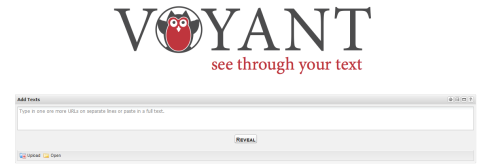To sum up the academic term in our Introduction to Digital Humanities class, everyone had to select a topic and make a presentation. Although there were many similarities among the chosen topics, it was interesting to see how the approach of each person considering their background differed. Gamification and Big Data were among the hottest topics with me opting for the latter. I was curious about the authenticity of Big Data and after reading Evelien’s post, did a little research on it and decided to focus on this for my presentation. In the next two posts, you can read a summary of this mini research.
One of the most interesting presentation was an analysis of our blog posts using the Voyant tool. After being introduced to this tool for digital text analysis by Prof. Berendt, it has become one of my favorite pastimes to run different books I have read to have a different review on its content and in some case have found a new perception of the book for example regarding surprising frequent words. Furthermore I have used the tool for a quick browsing of books I have not read to consider its potential application and value in a research paper I am writing on a specific subject. But in Mary’s analysis of our blogs using the Voyant tool, it became evident that Voyant is not just a tool to “see through your text” as is its slogan but perhaps even to see through the writers and in case of our blogs, us. When you press the reveal button, you may be disclosing more than you had expected! It actually can be not only a tool for such research on other texts but perhaps even a self-discovery tool! I am very curious to see what the most frequent words I have used are and what curated image of myself I am presenting on my blog. Hence I have decided to use the tool on my own blog and perhaps add it at the end of my series of blogs for the “Introduction to Digital Humanities”. If you don’t see the word cloud in the next few blog posts, you will know the result is too shocking or revealing!

One of the topics which I missed in the presentations and after reading Brendan’s blogpost was hoping to hear more about it was crowdsourcing for projects in Digital humanities. As it is a topic which I will be dealing with for my future work, I decided to do a more comprehensive research on crowdsourcing, the different experiences and approaches and its possible application for heritage (more specifically architectural heritage) and hopefully after writing the paper will post a blog about my findings. I am currently browsing through Crowdsourcing Our Cultural Heritage by Mia Ridge, Crowd-Sourcing Scoping Study Engaging the Crowd with Humanities Research, and articles such as From Crowdsourcing to Knowledge Communities: Creating Meaningful Scholarship Through Digital Collaboration and Digital Humanities and Crowdsourcing: An Exploration. It is already fascinating to see that crowdsourcing has been traced back to the early 1700s! Let see what has happened in the four centuries that follows…

*Opening Image Source: http://www.bobarron.com/wp-content/uploads/2013/09/iStock_000022922690Medium-1024×768.jpg
